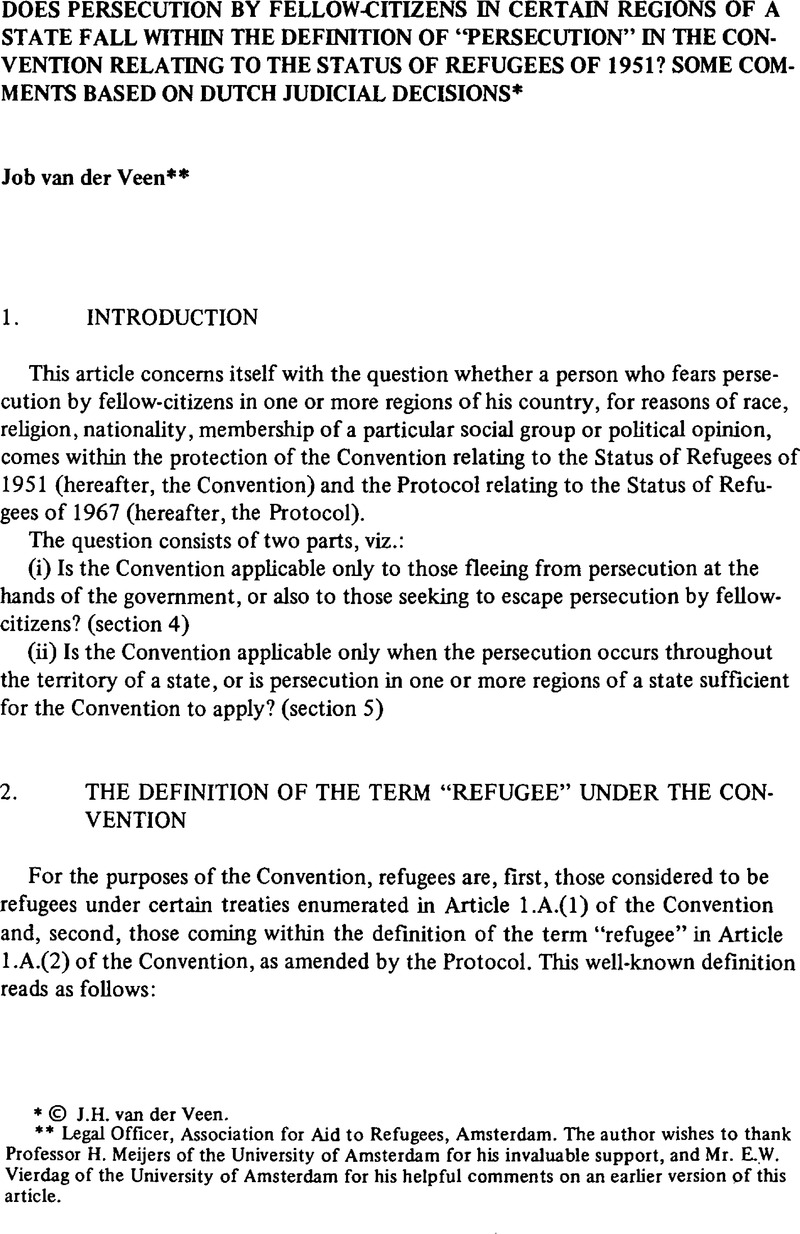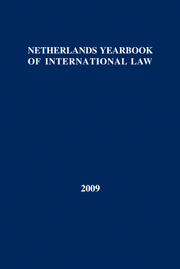No CrossRef data available.
Article contents
Does persecution by fellow-citizens in certain regions of a state fall within the definition of “persecution” in the Convention relating to the Status of Refugees of 1951? Some comments based on Dutch Judicial Decisions*
Published online by Cambridge University Press: 07 July 2009
Abstract

- Type
- Notes and Comments
- Information
- Copyright
- Copyright © T.M.C. Asser Press 1980
References
1. Art. 1.B lays down that states must at the time of signature, ratification or accession declare whether they understand the definition in Art. 1.A.(2) as applying only to persons becoming refugees as a result of “events occurring in Europe”, or as a result of “events occurring in Europe or elsewhere”. The Netherlands, which is a party to the Convention and the Protocol, has bound itself to apply the Convention without the geographical limitation. The Netherlands ratified the Convention on 3 May 1956, and the Protocol on 29 November 1968, “Multilateral treaties in respect of which the Secretary-General performs depositary functions”, UN Publ. Sales No. E.79.V.7 (UN Doc. ST/LEG/SER.D/12) pp. 126, 148.
2. “Fear” is a subjective concept, which is made objective by means of the adjective “well-founded”. See, van Panhuys, H.F., “Wat zijn de vereisten voor het verkrijgen van de status van vluchteling volgens het internationale recht?” Aspecten van vluchtelingenrecht [Aspects of refugee law] (Deventer, 1972) pp. 11–12Google Scholar, and Weis, P., “The concept of refugee in international law”, Journal du droit international (1960) p. 970.Google Scholar
3. The Ad Hoc Committee on statelessness and related questions of ECOSOC, which compiled a draft Convention, said on this point that a refugee must either have actually suffered persecution, or must be able to “show good reason why he fears persecution”. ECOSOC Off. Rec. 11th Sess., Annexes Agenda Item 32 p. 11 (UN Doc. E/1618 and Corr. 1).
4. In a case concerning refugees from Ethiopia, the Judicial Division of the (Netherlands) Council of State has found that “the well-founded fear of being persecuted (can) lie simply in membership of the Eritrean section of the population”. Decision of 10 April 1979, Rechtspraak Vreemdelingenrecht 1979 No. 3 and Gids Vreemdelingenrecht No. D.12–18. The decision of the Judicial Division was not in conformity with the view of the Representative of the UN High Commissioner for Refugees who, according to the decision, stated that “there are no arguments for granting refugee status, since the appellants have had no personal links with any of the Eritrean separatist movements, and have in no other way been involved with the political life of their country”.
The Judicial Division is an independent judicial division of the advisory body, the Council of State. On the basis of Arts. 29 and 34 of the (Dutch) Aliens Act, aliens have a right of Appeal to the Judicial Division against decisions of the Minister of Justice refusing them admission as refugees. If the decision is in accordance with the advice of a commission established for this purpose, then according to Art. 34, there is no appeal open, if on the day on which the decision is taken the person concerned has not already had his main residence in the Netherlands for a year. The Judicial Division has stated, however, in its decision of 20 December 1977, AB 1978 No. 188, that where Convention refugees are involved, these provisions must give way to Art. 16 of the Convention, which provides that Convention refugees – with no time stipulation – have a right of access to the courts. The Judicial Division made it known that it does not consider Art. 16 as applicable only to those admitted as refugees, but also to those claiming to be refugees and wishing to be admitted, up to the time that it appears to the court (the Judicial Division) that they are not refugees within the meaning of the Convention.
5. Weis, loc.cit., in n. 2 p. 970. For a comprehensive discussion of the concept of persecution, see, Grahl-Madsen, A., The Status of Refugees in International Law, Vol. I (Leiden, 1966) pp. 188–216.Google Scholar
6. Trb. 1954 No. 88 p. 52.
7. The relevant part of Art. 15 of the Aliens Act reads: “1. Aliens coming from a country where they have well-founded reasons to fear persecution on account of their religions or political convictions or their nationality, or on account of their membership of a particular race or a particular social group, may be admitted as refugees by the Minister.
2. Admission may not be refused other than for substantial reasons relating to the public interest, if the refusal would compel the alien to return immediately to a country as defined in para. 1….”. See, Swart, A.H.J., “The Dutch Law on Aliens”, in van Panhuys, H.F. et al. , eds., International Law in the Netherlands, Vol. 3 (Alphen aan den Rijn, 1980) pp. 81–108, at pp. 89–93.Google Scholar
8. See, the Note of the State-Secretary for Justice on Dutch policy relating to aliens, 28 June 1979, Bijl. Hand. II 1978/79 – 15649 No. 2 p. 23. For a comprehensive discussion of the law on refugees in the Netherlands, see, Swart, A.H.J., De toelating en uitzetting van vreemdelingen (Deventer, 1978) pp. 123-49, 473-91, 502-3Google Scholar; idem, loc.cit., in n. 7.
9. In the Netherlands they are given the so-called B Status, in place of refugee status based on the Convention. See, on this, Vierdag, E.W., “Enkele ontwikkelingen in het asiel- en vluchte-lingenrecht”, R.M. Themis (1977) pp. 350-6Google Scholar, and the Note on Dutch policy relating to aliens, supra in n. 8, at p. 24.
10. The Oxford English Dictionary (Oxford, 1933).Google Scholar
11. Robert, P., Dictionnaire alphabétique et analogique de la langue française (Paris, 1966).Google Scholar
12. Op.cit., supra in n. 5, at pp. 189–92.
13. Case IV ZB 58/65, ibid. p. 190.
14. Council of State, Judicial Division, 18 August 1978 (Turkish Christians case I), Rechtspraak Vreemdelingenrecht 1978 No. 30 and AB 1979 No. 159; an almost verbatim repetition is to be found in Council of State, Judicial Division, 21 June 1979 (Turkish Christians case II), Rechtspraak Vreemdelingenrecht 1979 No. 8 and AB 1980 No. 9.
15. Office of the UN High Commissioner for Refugees, Handbook on Procedures and Criteria for Determining Refugee Status under the 1951 Convention and the 1967 Protocol relating to the Status of Refugees (Geneva, 1979) p. 17.Google Scholar
16. Giahl-Madsen, op.cit., in n. 5, at p. 192.
17. Op.cit., in n. 15, at pp. 21–2.
18. Supra n. 14.
19. Supra n. 14. It appears from the judgments that the Representative in the Netherlands of the UN High Commissioner for Refugees also checks if the person concerned could be expected to “be able to establish a life for himself in other areas of Turkey”, in order to answer the question of the existence of a refugee situation. In the Turkish Christians case I, unlike in the Turkish Christians case II, the Representative, in contrast to the Judicial Division, considered that this could not be expected of the person concerned. It is a matter of dispute whether Turkish Christians are, anyway, free from persecution in other parts of Turkey. On the traditional place of asylum, Istanbul, see, Christian Minorities of Turkey (Brussels, 1979)Google Scholar, a report produced by the Churches Committee on Migrant Workers in Europe.
20. The determination by a State Party that a person is a Convention refugee is not a constitutive but a declaratory act. Art. 33(1) thus protects not only persons recognized as refugees, but also those who may reasonably be presumed to be refugees, until the opposite is shown. See, Grahl-Madsen, op.cit., in n. 5 pp. 340–1, and idem, op.cit., in n. 5, Vol. II (Leiden, 1972) pp. 224–5.
21. Weis, loc.cit., in n. 2, at p. 994.


